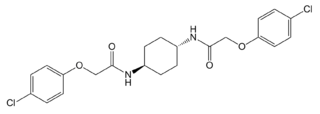ISRIB
 | |
| Clinical data | |
|---|---|
| ATC code | none |
| Identifiers | |
| |
| ChemSpider | 30773985 |
| Chemical and physical data | |
| Formula | C22H24Cl2N2O4 |
| Molar mass | 451.34 g/mol |
| 3D model (Jmol) | Interactive image |
| |
| |
ISRIB, (an acronym for Integrated Stress Response inhibitor), is an experimental drug which reverses the effects of eIF2α phosphorylation with an IC50 of 5nM. It was discovered by a group at the University of California through a semi-automated screening of a large library of small molecules. It has also been shown to inhibit eIF2α phosphorylation-induced stress granule (SG) formation.[1] Since eIF2α phosphorylation is known to be involved in memory formation, ISRIB was tested to see whether it would be active in vivo, and was found to readily cross the blood-brain barrier, with a half-life of 8 hours. Subsequent testing found ISRIB to produce significant nootropic effects in mice, as measured by enhancement of spatial and fear-associated learning in standard water maze and conditioned environment tests.[2]
See also
References
- ↑ Sidrauski, Carmela; McGeachy, Anna M.; Ingolia, Nicholas T.; Walter, Peter (26 February 2015). "The small molecule ISRIB reverses the effects of eIF2α phosphorylation on translation and stress granule assembly". 4: e05033. doi:10.7554/eLife.05033. PMC 4341466
 . PMID 25719440. Retrieved 13 September 2016 – via elifesciences.org.
. PMID 25719440. Retrieved 13 September 2016 – via elifesciences.org. - ↑ Sidrauski, C.; Acosta-Alvear, D.; Khoutorsky, A.; Vedantham, P.; Hearn, B. R.; Li, H.; Gamache, K.; Gallagher, C. M.; Ang, K. K. -H.; Wilson, C.; Okreglak, V.; Ashkenazi, A.; Hann, B.; Nader, K.; Arkin, M. R.; Renslo, A. R.; Sonenberg, N.; Walter, P. (2013). "Pharmacological brake-release of mRNA translation enhances cognitive memory". ELife. 2: e00498. doi:10.7554/eLife.00498. PMC 3667625
 . PMID 23741617.
. PMID 23741617.